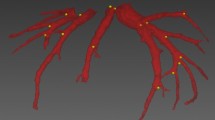Abstract
Objective:
A clinically realistic phantom incorporating respiratory motion was developed for validating image-guided systems for the liver.
Materials and methods:
The respiratory liver motion simulator consists of a physical human torso model which allows for an explanted human or porcine liver to be mounted adjacent to an artificial diaphragm. The apparatus can be connected to a lung ventilator for simulation of respiratory motion and is compatible with computed tomography (CT) and magnetic resonance imaging (MRI). To analyze the liver movement generated by the simulator, we examined three porcine livers mounted to the phantom and monitored their movement with a set of optically tracked fiducial needles.
Results:
Mean displacement between expiration and inspiration was 15.0 ± 4.7 mm, with craniocaudal movement making up the main part (14.2 ± 4.9 mm). In addition, the livers showed movement due to tissue deformation.
Conclusion:
The liver movement generated by the motion simulator is comparable to that of a human liver in vivo. The phantom thus provides a low-cost alternative to animal experiments for validating image-guided systems.
Similar content being viewed by others
References
Khamene A, Warzelhan JK, Vogt S, Elgort D, Chefd’Hotel C, Duerk JL, Lewin JS, Wacker FK, Sauer F (2004) Characterization of internal organ motion using skin marker positions. In: Barillot C, Haynor DR, Hellier P (eds) Proceedings of the 7th International Conference on Medical Image Computing and Computer-Assisted Intervention—MICCAI 2004 (2), pp 526–533, Saint-Malo, France. Springer, Berlin
Fichtinger G, Deguet A, Fischer G, Iordachita I, Balogh E, Masamune K, Taylor RH, Fayad LM, Zinreich SJ and Oliveira M (2005). Image overlay for CT-guided needle insertions. Comp Aid Surg 10(4): 241–255
Khan MF, Dogan S, Maataoui A, Wesarg S, Gurung J, Ackermann H, Schiemann M, Wimmer-Greinecker G and Vogl TJ (2006). Navigation-based needle puncture of a cadaver using a hybrid tracking navigational system. Invest Radiol 41(10): 713–720
Zhang H, Banovac F, Lin R, Glossop N, Wood BJ, Lindisch D, Levy E and Cleary K (2006). Electromagnetic tracking for abdominal interventions in computer aided surgery. Comp Aid Surg 11(3): 127–36
Nagel M, Hoheisel M, Petzold R, Kalender WA, Krause UHW (2007) Needle and catheter navigation using electromagnetic tracking for computer-assisted C-arm CT interventions. In: Cleary KR, Miga MI (eds) Proceedings of SPIE Medical Imaging 2007: visualization, Image-Guided Procedures, and Display, vol 6509, p 65090J (9 pages), San Diego, CA, USA
Maier-Hein L, Müller SA, Pianka F, Seitel A, Müller-Stich BP, Gutt CN, Rietdorf U, Richter G, Meinzer H-P, Schmied BM, Wolf I (2007) In-vitro evaluation of a novel needle-based soft tissue navigation system with a respiratory liver motion simulator. In: Cleary KR, Miga MI (eds) Proceedings of SPIE Medical Imaging 2007: Visualization and Image-Guided Procedures, vol 6509, p 650916 (12 pages), San Diego, CA, USA
Clifford MA, Banovac F, Levy E and Cleary K (2002). Assessment of hepatic motion secondary to respiration for computer assisted interventions. Comp Aid Surg 7: 291–299
Banovac F, Tang J, Xu S, Lindisch D, Chung HY, Levy EB, Chang T, McCullough MF, Yaniv Z, Wood BJ and Cleary K (2005). Precision targeting of liver lesions using a novel electromagnetic navigation device in physiologic phantom and swine. Med Phys 32(8): 2698–2705
Cleary KR, Banovac F, Levy E, Tanaka D (2002) Development of a liver respiratory motion simulator to investigate magnetic tracking for abdominal interventions. In: Mun SK (ed) Proceedings of SPIE Medical Imaging 2002: visualization, Image-Guided Procedures, and Display, vol 4681, pp 25–29
Lin R, Wilson E, Tang J, Stoianovici D, Cleary K (2007) A computer-controlled pump and realistic anthropomorphic respiratory phantom for validating image-guided systems. In: Proceedings of SPIE Medical Imaging 2007: visualization and Image-Guided Procedures, vol 6509, p 65090E (9 pages), San Diego, CA, USA
Maier-Hein L, Pianka F, Seitel A, Müller SA, Tekbas A, Seitel~M, Wolf I, Schmied BM, Meinzer H-P (2007) Precision targeting of liver lesions with a needle-based soft tissue navigation system. In: Ayache N, Ourselin S, Maeder A (eds) Proceedings of the 10th International Conference on Medical Image Computing and Computer-Assisted Intervention—MICCAI 2007 (2), vol 4792, pp 42–49, Brisbane, Australia. Springer, Berlin
Author information
Authors and Affiliations
Corresponding author
Rights and permissions
About this article
Cite this article
Maier-Hein, L., Pianka, F., Müller, S.A. et al. Respiratory liver motion simulator for validating image-guided systems ex-vivo. Int J CARS 2, 287–292 (2008). https://doi.org/10.1007/s11548-007-0140-2
Received:
Accepted:
Published:
Issue Date:
DOI: https://doi.org/10.1007/s11548-007-0140-2




